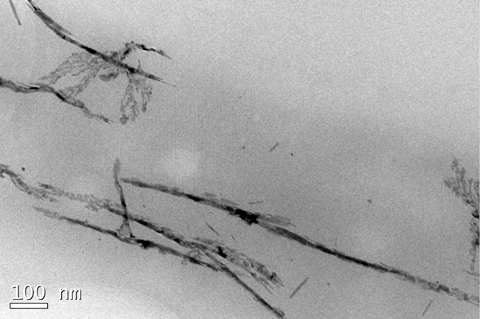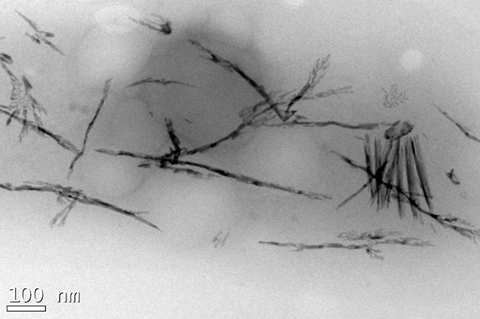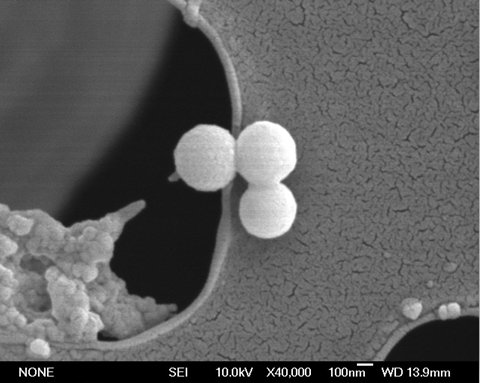A research group working on using microbes to transform toxic metals into valuable metallic nanoparticles has designed a form of E. coli that can resist 1,000 times more tellurite than its wild-type counterpart.
The team at Centro de Investigaciones Biológicas Margarita Salas-CSIC in Spain has also sped up the production of selenium nanoparticles using Vibrio natriegens as a bioreactor.

They outline their recent challenges and the way forward in a paper, ‘Opportunities and obstacles in microbial synthesis of metal nanoparticles’, which appears in Microbial Biotechnology [link], an Applied Microbiology International publication.
Metabolising toxins
The group, led by Eduardo Díaz and Manuel Carmona, is working on the study of the metabolic and regulatory networks that control the bacterial metabolism of toxic compounds and biowaste, many of which are major environmental pollutants.
One line of research is related to the bioconversion of toxic metals into metallic nanoparticles (MeNPs), using bacteria as bioreactors.
MeNPs are involved in a huge amount of applications, some of them strategic, eg electronics, including computers, high-resolution screens, smartphones, satellite communication; biomedical devices and biomarkers; cosmetics; and food supplements.
Chemical synthesis is the most developed procedure for MeNP production, but often requires harsh conditions, highly polluting compounds and a lot of energy.
Biological production, on the other hand, is an eco-friendly and less energy-demanding alternative for generating MeNPs. The ultimate goal is the eco-friendly generation of circular economy systems of MeNP production.
Bacterial biofactories
“Our group is interested in the bioproduction of MeNPs using bacteria as biofactories. This alternative method produces highly homogeneous (in size and shape) MeNPs, with organic compounds surrounding the nanoparticle to avoid aggregation and making them highly biocompatible,” corresponding author Dr Manuel Carmona says.
“Nevertheless, several limitations in the biological production of MeNPs should be solved, eg. poor knowledge of the molecular determinants responsible for MeNP synthesis, searching for robust bacterial chassis - these need to be easy to handle, with low nutritional requirements, fast speed of growth, feasible to be genetically modified and capable of resisting moderate or high concentrations of toxic metals - and setting scale-up protocols for industrial needs.”

The team has reported on their success in speeding up production of selenium nanoparticules by using the well-known fast-growing bacterium Vibrio natriegens as bioreactor, and more recently increased the removal of tellurite and the production of tellurium nanoparticles in the model bacterium Escherichia coli by overproduction of one methyltransferase involved in tellurite methylation, as reported in Microbial Biotechnology.
Tellurite challenges
“Tellurite is a very toxic metalloid that can be present in the environment, mainly as a consequence of industrial contamination,” Dr Carmona says.
“Tellurium is widely used in technological applications and tellurium nanorods are very appreciated for the construction of nanowires with special electronic properties.

“Although Escherichia coli is very sensitive to tellurite, we designed an E. coli that resists 1,000 times more tellurite than the wild-type strain, and used this strain as a tool for conversion of pollutant tellurite into tellurium nanorods.
“This strategy can be imitated to develop bacteria able to recycle pollutant metals and metalloids present in the environments into added-value products.”
Pushing through limitations
To address all the existing limitations on bioproduction of MeNPs, he says, researchers will need to expand the number of bacterial biocatalysts capable of producing MeNPs, and increase knowledge of the molecular determinants involved in MeNP synthesis.
They will also need to implement laboratory conversion yields to the industrial scale for satisfying society’s demands, and explore the production of novel MeNPs that have yet to be obtained.

“In summary, we need to obtain more basic knowledge for the rational production of MeNPs, and then we aim to develop these bioprocesses at the industrial scale,” Dr Carmona says.
This work is supported by grants from the Agencia Estatal de Investigación (AEI), from the Spanish Ministerio de Ciencia de Innovación (MICIIN) and the European Union Next Generation programme.
‘Opportunities and obstacles in microbial synthesis of metal nanoparticles’, is published in Microbial Biotechnology [link].
Supporting documents
Click link to download and view these files4
Image, FileSizeText 2.56 mb
Topics
- Applied Microbiology International
- bioconversion
- Centro de Investigaciones Biológicas Margarita Salas-CSIC
- Climate Action
- Community
- Eduardo Díaz
- Escherichia coli
- Healthy Land
- Industrial Microbiology
- Manuel Carmona
- metallic nanoparticles
- Research News
- selenium
- Synthetic Biology
- tellurite
- tellurium
- toxic metals
- UK & Rest of Europe
- Vibrio natriegens







No comments yet